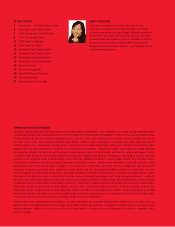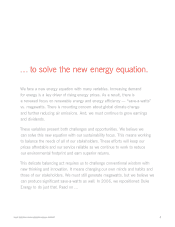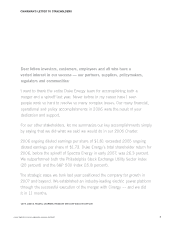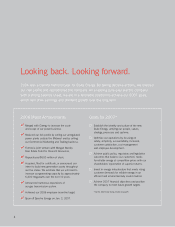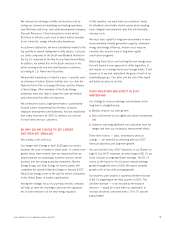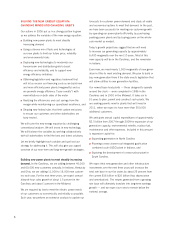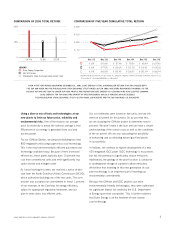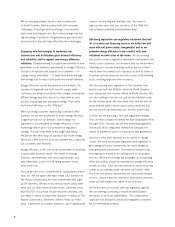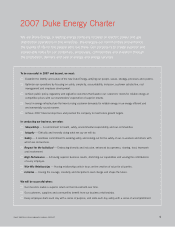Duke Energy 2006 Annual Report Download - page 7
Download and view the complete annual report
Please find page 7 of the 2006 Duke Energy annual report below. You can navigate through the pages in the report by either clicking on the pages listed below, or by using the keyword search tool below to find specific information within the annual report.DUKE ENERGY 2006 SUMMARY ANNUAL REPORT 5
We reduced our earnings volatility and business risk by
selling our commercial marketing and trading operations,
and effectively half of our real estate development company,
Crescent Resources. These transactions raised almost
$2 billion in after-tax cash, most of which will be invested
in our lower-risk, energy infrastructure businesses.
In customer satisfaction, we have consistently ranked in the
top quartile in several independent utility studies. Last year,
our utility companies in the South and Midwest finished in
the top 10 nationally in the Key Account Benchmark Study.
In addition, we ranked first in the South and best in the
nation among small and mid-sized business customers,
according to J.D. Power and Associates.
We provided leadership on industry issues. I currently serve
as chairman of Edison Electric Institute and I co-chair the
National Action Plan on Energy Efficiency and the Alliance
to Save Energy. Other members of the Duke Energy
leadership team also help to shape the state and federal
policy decisions that affect our business.
We continued to build a high-performance, sustainability-
focused culture characterized by diversity, inclusion,
employee development and leadership. And we established
new safety incentives for 2007 to reinforce our concern
for each other and our customers.
SO WHY DID WE CHOOSE TO GET LARGER
AND THEN GET SMALLER?
Very simply, scale and focus.
Our merger with Cinergy in April 2006 gave our electric
business the scale it needed to stand alone. To unlock even
greater value, three months later we announced that we
would separate our natural gas business and our electric
business into two strong pure-play companies: Spectra
Energy for gas and Duke Energy for electric power. We
completed the spinoff of Spectra Energy in January 2007.
Today Duke Energy is one of the top five electric companies
in the United States in market capitalization.
Having the strategic focus of a pure-play electric company
will help us meet the challenges and seize the opportuni-
ties to solve what we call the new energy equation.
In this equation, we must meet our customers’ needs
for affordable and reliable electric power while meeting
more stringent environmental rules that will inevitably
increase costs.
We must raise capital for long-term investments in more
environmentally friendly generation capacity, renewable
energy and energy efficiency. And we must reassure
investors who may be wary of long-term capital
construction programs.
Balancing these factors and solving the new energy equa-
tion will require a new approach to utility regulation. It
will require us to change minds and change habits. It will
require us to see and understand the goals of each of our
stakeholder groups. This letter and the rest of this report
will detail our plans to do that.
WHAT INVESTORS CAN EXPECT IN 2007
AND BEYOND
Our strategy to increase earnings and dividends in the
long term is straightforward:
Steadily improve our sales growth
Earn solid returns on our significant capital investments,
and
Continue achieving additional cost reductions from the
merger and from our continuous improvement efforts.
These three drivers — sales, investments and cost
savings — are essential to achieving both our 2007
financial objectives and long-term growth.
You can read all of our 2007 objectives in our Charter on
page 9. Our 2007 employee incentive target of $1.15 per
share is based on ongoing diluted earnings. The $1.15
serves as the basis for 4 to 6 percent annual earnings
growth through the end of 2009. We expect dividend
growth to be in line with earnings growth.
Our business plan projects a quarterly dividend increase
of $0.01 beginning in the third quarter of 2007. This
dividend increase — to be decided by the board of
directors — would be in line with our expectation to
increase dividends consistent with a 70 to 75 percent
payout target.
■
■
■


